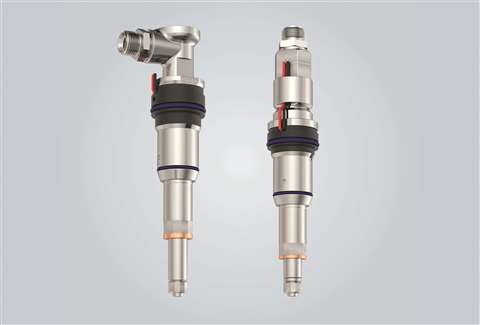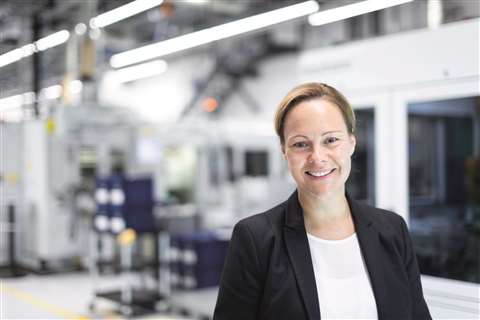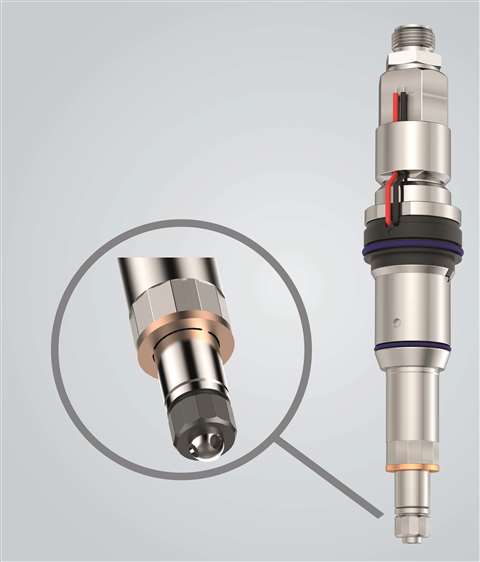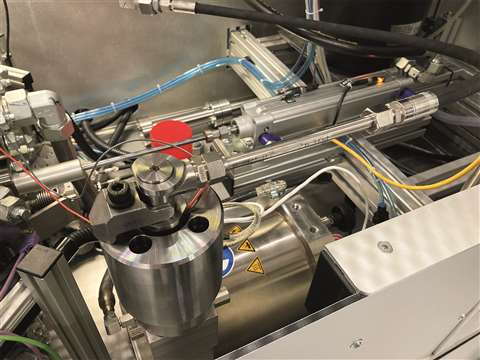Liebherr’s hydrogen fuel injection for combustion engines
02 June 2022
 Liebherr’s Fuel Systems business is developing low-pressure direct injection hydrogen fuel systems for combustion engines. (Photo: Liebherr)
Liebherr’s Fuel Systems business is developing low-pressure direct injection hydrogen fuel systems for combustion engines. (Photo: Liebherr)
There seems little doubt that for the long term, hydrogen is viewed as the fuel of the future for mobile and stationary applications. Ultimately, it’s seen as the enabling technology behind fuel cells.
Yet more recently, hydrogen has also been considered as a possible fuel for new generations of low- or zer
o-carbon internal combustion engines. Hydrogen combustion engines, many believe, could serve as a bridge technology until fuel cells are fully ready for prime time, delivering significant reduction in emissions in a familiar platform and doing it at a lower cost than fuel cells or battery electric systems.
For that to occur; however, a number of engine systems will need to be adapted or developed to allow them to run on H2, and perhaps the most critical of these are fuel injection systems.
One company that has been active in the development of hydrogen fuel systems is Liebherr with its product segment fuel injection equipment. The company’s Fuel Systems business has been working on hydrogen injection systems for internal combustion engines for some years and is already running real engine tests of its low-pressure direct injection (LPDI) technology.
“We are currently seeing a lot of interest from OEMs and customers in hydrogen combustion engines,” said Stefanie Gerhardt, managing director of Liebherr’s Fuel Systems business. “We also see that federal legislation is pushing toward decreasing CO2 emissions.
 “We are currently seeing a lot of interest from OEMs and customers in hydrogen combustion engines.” - Stefanie Gerhardt, Liebherr Fuel Systems
“We are currently seeing a lot of interest from OEMs and customers in hydrogen combustion engines.” - Stefanie Gerhardt, Liebherr Fuel Systems
“There is also interest because with the H2 combustion engine, many components can be adopted from existing diesel engines and existing manufacturing facilities can continue to be used. Some engine designs may need to change because of using hydrogen.”
Hydrogen fuel injection
Liebherr’s development efforts have focused on diesel fuel systems for heavy-duty engines from 7 to 100 L in displacement. It’s no accident that those displacements blanket the majority of on- and off-road engine applications.
“The basic diesel engine design of today can be used in both types of applications,” Gerhardt said. “That will also be possible with the future hydrogen combustion engines. In our development of hydrogen fuel systems, we have taken these specific requirements into account in our solutions.”
The company’s LDPI development efforts have focused on injectors with injection pressures of 30 to 60 bar (435 to 870 psi). The injector can be used as part of a common rail system in a spark-ignited engine or could also be part of a dual-fuel system, with diesel or a synthetic “e-fuel” used for pilot injection and ignition of the hydrogen.
“Our low-pressure technology is a spark ignition technology,” Gerhardt said. “But the technology could also be used with dual-fuel, or with other fuels. For use in compression ignition engines, a high-pressure direct injection system will be required, and we are considering this development, as well.”
“Actuation of a gas injector is significantly different from diesel technology. However, our overall expertise in fuel injection technology has helped drive the development process for the hydrogen fuel injection system in the right direction.”
Overcoming the differences
There are several differences – and challenges – involved with developing hydrogen fuel systems. “One of our first development targets has been to ensure the dry-running capability of the hydrogen injector,” Gerhardt said. “It works smoothly without any lubricating oil at all, which prevents inadvertent pollution of the hydrogen inside the injector.
 Liebherr’s LPDI injectors incorporate a flexible blow cap design that allows for different injection angles into the combustion chamber. (Photo: Liebherr)
Liebherr’s LPDI injectors incorporate a flexible blow cap design that allows for different injection angles into the combustion chamber. (Photo: Liebherr)
“We do not have any natural gas injection products in our portfolio where we could have carried over some design concepts. This required us to run a series of tests, especially with regard to the needle guidance. At the end we could find a solution that is feasible without significant abrasion and meets all specifications of the endurance tests.”
A further issue with hydrogen is “embrittlement,” a weakening of metals caused by the diffusion of hydrogen into the material. As a preventative measure, Gerhardt said Liebherr used special austenitic steels, resistant to diffusion and hydrogen-induced stress cracking on specific injector surfaces.
In developing its prototype injectors, Liebherr sought to support a broad range of potential installations on OEM engines, with customer-specific screw inserts for interfacing with the hydrogen connection. The injector blow cap was also designed for flexibility, with an asymmetrical geometry that allows for different injection angles into the combustion chamber.
The company is also working on solutions for port fuel injection for heavy-duty engines from 7 to 15 L with an injection pressure of 15 bar (217 psi). “ Behavioral and performance requirements for an application are extremely diverse,” Gerhardt said. “Right now, on the threshold to new powertrain technologies, this is becoming even more apparent – particularly as our own machines require this large spectrum, as well.”
Putting injectors to the test
Liebherr has conducted laboratory testing of its fuel injector along with testing the injectors on various engines.
“We started first with the injectors only, and in the end our target is to build a complete system,” said Gerhardt. “That means including the pressure control and hydrogen gas metering system.
 Liebherr LPDI hydrogen fuel injectors on a test bench in Germany. The company plans to begin testing of a complete fuel system at the end of the second quarter. (Photo: Liebherr)
Liebherr LPDI hydrogen fuel injectors on a test bench in Germany. The company plans to begin testing of a complete fuel system at the end of the second quarter. (Photo: Liebherr)
“The complete system will begin testing on engines, we expect, at the end of the second quarter of 2022.”
All of the fuel systems development is taking place at Liebherr-Components Deggendorf GmbH in Bavaria, Germany. The company’s competence center for injection technology since 2015, the facility’s 500-person staff designs and manufactures everything from components such as injectors and high-pressure pumps to complete fuel systems for medium- and heavy-duty engines.
STAY CONNECTED




Receive the information you need when you need it through our world-leading magazines, newsletters and daily briefings.
POWER SOURCING GUIDE
The trusted reference and buyer’s guide for 83 years
The original “desktop search engine,” guiding nearly 10,000 users in more than 90 countries it is the primary reference for specifications and details on all the components that go into engine systems.
Visit Now
CONNECT WITH THE TEAM









